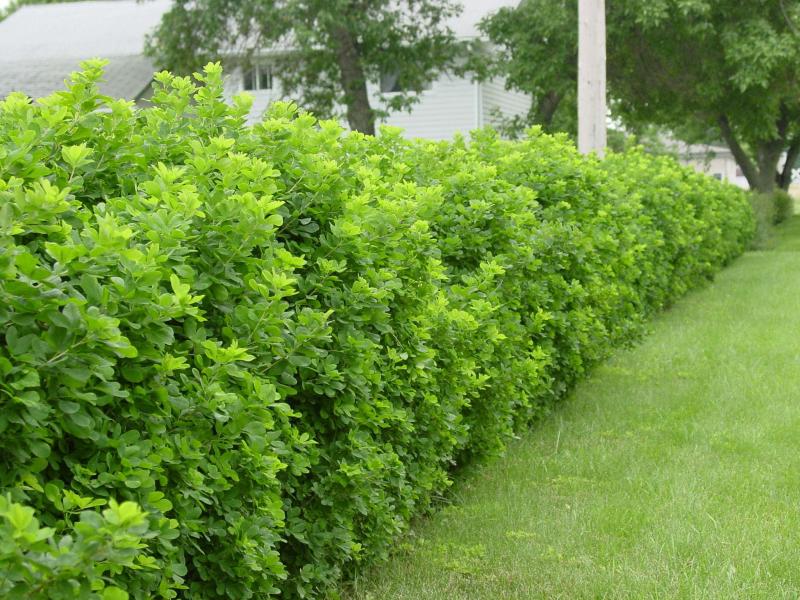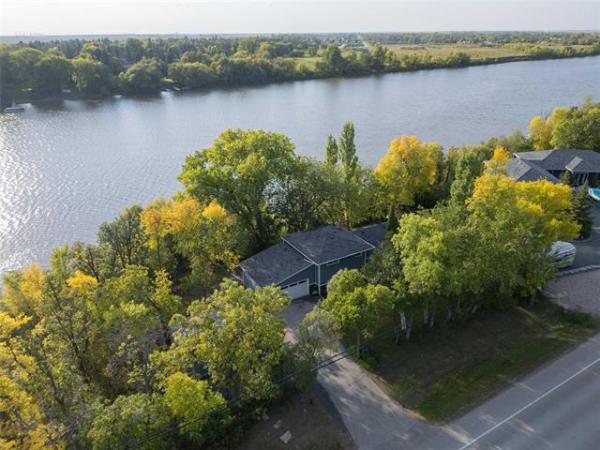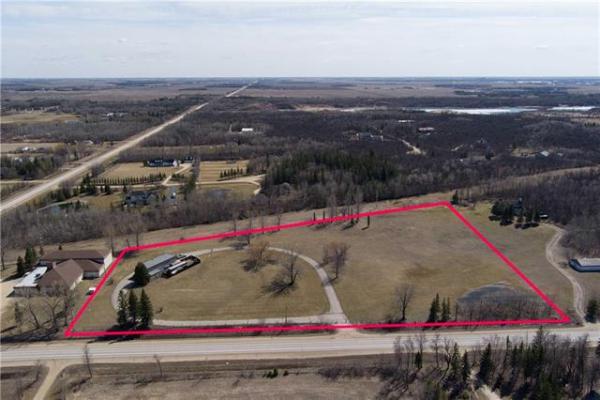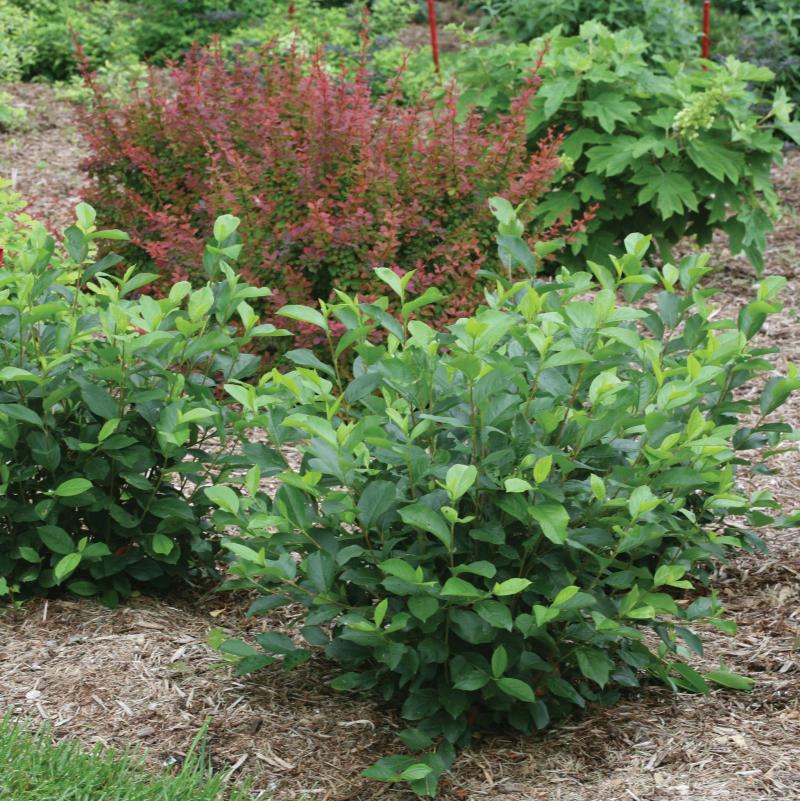
Tired of the same old choices? Aronia Viking chokeberry is a superior shrub for the landscape and can be used in hedges.
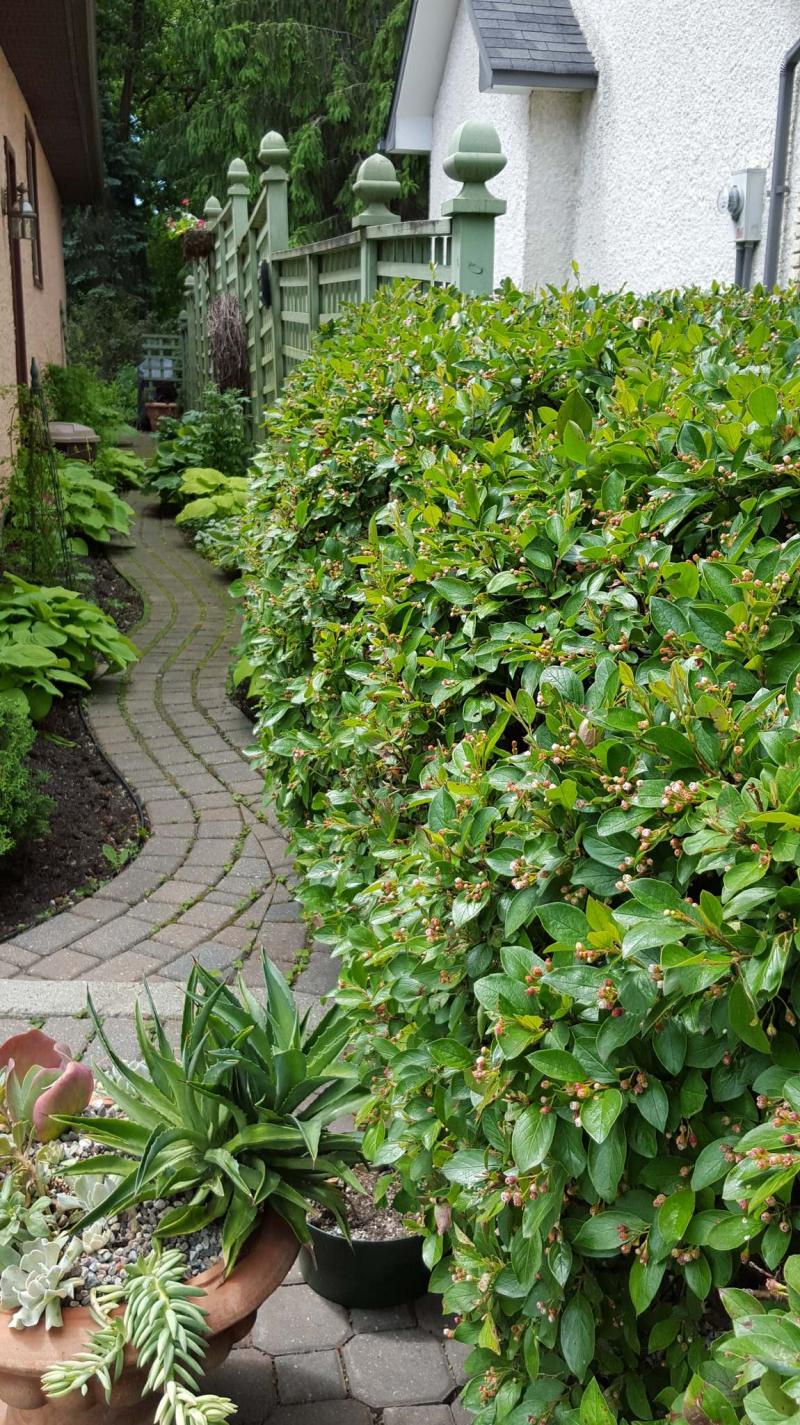
This 35-year old hedge cotoneaster in an East Kildonan garden maintains its good looks with regular pruning and inspection.
A tightly clipped, well-maintained hedge is often an essential part of the formal landscape. Beautiful yet practical, hedges, whether formal or informal, can serve many functions. Hedges may be used as a means to separate two different areas in the landscape or mark boundaries between neighbouring properties, or serve as a privacy enclosure or windbreak. More than that, there is considerable effect achieved by creating plant masses that emphasize form, texture as well as four season value.
One of the most iconic garden choices, Boxwood (Buxus), with its dense habit and small evergreen leaves, can be easily trimmed and shaped into a low-growing hedge. Overwintering boxwood in our climate, though, isn’t so simple. Two varieties that are relatively hardy, Calgary and Green Mountain, often become unsightly from severe winter burn unless the proper precautions are taken (protected location, adequate moisture).
Typical shrub choices for a hedge include cotoneaster, alpine currant, lilac and caragana. Native to Siberia, cotoneaster grows to a mature height of two metres, produces small blue-black berries and is suitable for a full sun or light shade location. The small, glossy green leaves turn a striking red in the fall. Hedge Cotoneaster (Cotoneaster lucidus) is beautiful when it is healthy but unfortunately its susceptibility to fireblight has cut its use.
Fireblight is a bacterial disease that appears during the summer, usually during warm and humid conditions, and is identified by red and fire-scorched young leaves and twigs. Recently, on a visit to East Kildonan I saw a cotoneaster shrub that looked exactly as it should, neatly trimmed with dense, uniform growth. Planted more than 30 years ago, the homeowners make a point of monitoring it for any signs of disease, pruning back infected branches into healthy wood and ensuring that pruners are sanitized before each new pruning cut.
Alpine currant (Ribes alpinum) is suitable for low hedges. The most commonly used variety is Schmidt. If your goal is a more formal, traditional hedge, alpine currant can easily be shaped and pruned for a structured look, however, powdery mildew can be a recurring problem with this species, even in areas with good air circulation.
Lilac (Syringa) makes an ideal choice for a hedge providing it receives adequate sunlight. In older neighbourhoods where spreading tree canopies have edged out the available sunlight, it’s not uncommon to see lengthy rows of two-metre tall lilac hedges with numerous gaps as the shaded lower portions of the shrubs gradually lose their leaves. In areas where light is not a limiting factor, two varieties of lilac that are good choices for hedges are Minuet (Syringa x Prestoniae) and Dwarf Korean (Syringa meyeri).
Gerry Aubin, owner of Aubin Nurseries in Carman, particularly likes Minuet for its compact, vase shape which lends itself to a more formal look unlike the open, sprawling appearance of other lilac varieties. In addition to a tighter form, Aubin says the large leaves of Minuet are a deeper green. Hardy to zone 2, Minuet grows to two metres and produces an abundance of pink-white blooms in early summer. Lilacs thrive in well-drained soil that has been amended with plenty of organic matter.
Caragana comes in a variety of forms suitable for hedges. Aubin particularly likes Globe caragana (Caragana frutex Globosa). "It gives the formal look of boxwood but has twice the hardiness," he says. A true dwarf shrub (maximum height 0.9 metres) with dense foliage, Aubin says that one distinct advantage of Globe caragana is that it needs only minimal pruning.
Viking chokeberry (Aronia melanocarpa) is a superior shrub for the landscape, says Aubin, and would be very attractive in a mass planting. It has darker, glossier foliage than cotoneaster as well as attractive black berries for a striking contrast in fall against the brilliant red foliage. The berries are edible and can be used for making jelly. A medium-size shrub (1.5 metres), Viking chokeberry is suitable for a sunny to part sun location.
A taller shrub (two metres) suitable for screening, says Aubin, is Red Wing Cranberry Viburnum (Viburnum trilobum J. N. Select). Aubin claims this is his favourite viburnum because of the rich reddish-green colour of the foliage that is present throughout the summer. White spring flowers and abundant clusters of bright red fruit from late fall through early winter provide significant ornamental impact in the landscape.
Baby Bear cedar (Thuja occidentalis Skinner’s), though, has massive appeal as a screen or hedge, says Aubin who calls it a major breakthrough. "It is the first and only hardy dwarf cedar for Manitoba," says Aubin who emphasizes its resistance to winter sunscald. That is a breakthrough, indeed. Aubin says that homeowners are fed up with winter burn on cedars. Developed in northern Manitoba, Baby Bear grows to a mature height of two metres with a width of only one metre. An evergreen, no pruning is required apart from removing feathery new growth. A northeast exposure is ideal although it can be planted almost anywhere. A south-facing exposure could risk some dessication.
Shawna Bell, vice-president at Jeffries Nurseries, Portage la Prairie, says demand continues to grow for Morden Yew (Taxus cuspidata), a dense evergreen shrub that can be grown in sun or shade. Bell suggests, though, that a protected location is preferred. Compact (1.25 metres), yew adds intriguing texture and deep green colour to the landscape and responds well to clipping. Of interest, too, is the red, berry-like fruit enclosed by a fleshy, scarlet aril. This plant requires a location with good drainage.
Certain types of shrub roses or hydrangea can also be used to create a hedge. That’s a classic and elegant look, says Bell, that would be worthy of a spot in our gardens providing sufficient sunlight is available to promote and sustain flowering. "Prairie Joy rose, for example," says Bell, "grows 11/2 metres tall and has excellent disease resistance." A hardy Parkland rose, this dense, thorny plant produces double pink flowers and would make a stunning hedge. Underplanting on either side of the rose hedge with a low growing shrub such as Royal Burgundy Barberry (60 cm) would be particularly striking.
Paniculata hydrangea varieties such as QuickFire, Limelight, Pink Diamond or Fire and Ice have sturdy stems, making them suitable choices for a flowering hedge. Each has open, lacy blooms that, while substantial, maintain their upright form without weighing down stems. A minimum amount of sunlight is required to ensure blooms, but all of these hydrangea varieties would be good options for a site that has full morning sun and mostly afternoon shade. Hydrangeas require well-drained, moist soil.
When I asked Karl Sorensen, Jensen’s Nurseries, which shrubs he would suggest for a hedge he first singled out Pygmy Caragana. Slightly taller than Globe Caragana, Pygmy Caragana has ascending branches and showy yellow flowers in mid- to late May. Once established, it is tolerant of dry alkaline soils. Its fine-textured foliage looks soft to the touch but conceals tiny thorns.
Where space permits for a large hedge, Sorensen recommends American Hazelnut (Corylus Americana). An upright, spreading shrub with coarse green-toothed foliage and catkins in spring followed by edible 1.5 cm nuts, this shrub grows to two metres tall. Sorensen says that moisture is needed until the shrub is established. It should be spaced one to 1.5 metres apart.
Sorensen says when shrubs become woody, pruning out some of the older stems from the bottom of the shrub improves air circulation and encourages fresh, new growth.
When pruning a hedge, the base should be broader than the top. This allows light to more easily penetrate the lower branches of the hedge and prevent the foliage from dying out. Use only pruners to maintain the shape of shrubs such as hydrangeas and shrub roses. Hand shears may be used to trim fresh leafy growth on deciduous shrubs such as cotoneaster or alpine currant in order to maintain the desired shape. Electric or gas-powered hedge trimmers are used for trimming branches and require a level of skill as well as safety precautions.
Proper spacing is important for any plant but even more so when designing a hedge. Take into consideration a plant’s mature width and divide by two to calculate the amount of distance required from a fence or property line and in between plantings. While waiting for a hedge to fill in, herbaceous perennials can be planted into the spaces between shrubs and then replanted into a garden bed at a later date.
colleenizacharias@gmail.com

